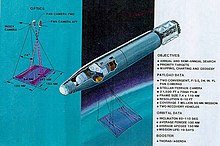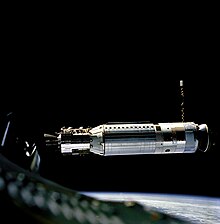Agena
The Agena was a varied set up US school for aerospace - launchers . Its development was based on the knowledge gained after the first satellite launches at the end of the 1950s that precisely defined orbits are necessary for the successful use of a satellite (e.g. for reconnaissance ) . These could not be realized by the single ignitable solid rocket stages used up to now .
Development history
From 1955 it became clear to the military that an essential application of satellite technology would be the reconnaissance of the foreign territory. The WS 117L program (WS for Weapons System) was founded for this purpose. The core was a photo reconnaissance satellite, the recordings of which were to be taken back to earth on films in capsules ( keyhole CORONA ). When returning, the idea was to have the capsules hanging on the parachute caught by airplanes in order to allow as little "enemy loss risk" as possible. The prerequisite was a satellite that could maneuver in orbit (i.e. had a re-ignitable engine and attitude control). In October 1956, the Lockheed company got the contract because it was able to fall back on developments (which had already been discontinued at the time) for a controllable missile projectile for nuclear warheads of the B-58 Hustler bomber . The US Air Force designated this missile as the RM-81 Agena. The satellites became known as the Discoverer . The storable combination of nitric acid / UDMH was selected as the fuel . The specialty of the Agena upper stage was that in most cases it stayed together with the actual payload. Only parts were separated after a long joint flight to return or as a space probe.
Agena A
The first Agenas used the Bell XLR81-BA-3 (Model 8001) engines, but most of them used the XLR-81-BA-5 (Model 8048) with approximately 69 kN (15,500 lb) of thrust for a burn time of 120 s. The engine had gimbaled nozzles for pitch and yaw control. The Thor Agena A launched the first optical CORONA -Aufklärungssatelliten the Discoverer series (KH-1 for Keyhole on German keyhole ). The combination Atlas-Agena A was used for the Midas (Missile Detection and Surveillance) early warning system before missile launches and the ELINT system called Samos (Satellite and Missile Observation System) for electronic surveillance.
Agena B
The Agena B represented a further development of the Agena A by extending the tanks and using Bell XLR-81-BA-7 (model 8081) engines. These engines were re-ignitable in a vacuum, had approx. 71 kN (16,000 lb ) Thrust, and the total burn time doubled to 240 s. Later variants used the Bell XLR-81-BA-9 (model 8096) engine. The Thor-Agena B was used again for satellites of the Keyhole series (KH-2/3/4/5) and partly for the Samos program. The Atlas-Agena B for Midas and Samos . The Ranger moon and space probes were also launched with it.
Agena C
Planned further development with tank capacity doubled again - not implemented
Agena D

While the Agena A and B were specially adapted for each mission, the Agena D was created on the basis of the Agena B, the first standardized platform for payloads for Thor, Atlas and Titan missiles . The payload was accommodated in the nose cone or, as in the case of the Keyhole satellites, remained firmly attached to the Agena. In addition, small secondary payloads could be attached to the stern of the step . Payloads included a. the Mariner planetary probes, but also the Gemini Agena Target Vehicles , target satellites for coupling experiments as part of the Gemini program . However, the majority of the payloads were military. The satellites of the optical CORONA reconnaissance satellites (KH-4 / 4A / 4B), ARGON (KH-5) and LANYARD (KH-6) were launched with the Thor variants. The Atlas (LV-3A / SLV-3) launched the optical GAMBIT (KH-7), the Atlas SLV-3A launched the CANYON / RHYOLITE / AQUACADE satellites for electronic reconnaissance ( ELINT / SIGINT ) into geostationary orbits. The GAMBIT optical reconnaissance program (KH-8) was continued with the Titan 3B / 23B / 24B. The larger Titan 33B / 34B were again used for the SIGINT-JUMPSEAT satellites.
Technical specifications
Upper grades
| Type | Agena A | Agena B | Agena D |
|---|---|---|---|
| length | 5.94 m | 7.56 m | 7.09 m |
| diameter | 1.52 m | ||
| Dimensions | 3850 kg | 7167 kg | 6821 kg |
| Empty mass | 885 kg | 867 kg | 673 kg |
| Fuel weight | 2945 kg | 6115 kg | |
| drive | Bell 8001/8048 (XLR81-BA-3/5) 68.9 kN for 120 s |
Bell 8081 (XLR81-BA-7) 71.1 kN for 240 s |
Bell 8096 (XLR81-BA-9) 71.1 kN for 240 s |
Engines
| Engine | Bell 8048 (Agena A) | Bell 8081 (Agena B) | Bell 8096 (Agena D) | Bell 8247 (GATV) |
|---|---|---|---|---|
| thrust | 68.9 kN |
71.2 kN
|
||
| Weight | 127 kg | 130 kg | 140 kg | 132 kg |
| length | 2.16 m | 2.11 m | ||
| Max. Diameter |
1.52 m
|
|||
| Specific impulse (vacuum) | 2707 m / s | 2834 m / s | 2874 m / s | 2855 m / s |
| Combustion chamber pressure | 10 bar | 17.5 bar | 35 bar | 34 bar |
| Expansion ratio | 10: 1 |
45: 1
|
||
| Burn time | 120 s |
240 s
|
||
| Reignitions | 2, later 3 | > 15 | ||
| ignition | pyrotechnic | Starting tanks | ||
Agena level start list
| Missile type | Number of starts | First start | Last use |
|---|---|---|---|
| Thor (SLV-2) + Agena A | 16 | 01/21/1959 | 09/13/1960 |
| Atlas (LV-3A) + Agena A | 4th | 02/26/1960 | 01/31/1961 |
| Overall Agena A | 20th | ||
| Thor (SLV-2) + Agena B | 44 | 10/26/1960 | 08/28/1964 |
| Thrust-Augmented Thor (SLV-2A / C) + Agena B |
3 | 06/29/1963 | 05/15/1966 |
| Atlas (LV-3A) + Agena B | 28 | 07/12/1961 | 03/21/1965 |
| Atlas (SLV-3) + Agena B | 1 | 06/09/1966 | |
| Overall Agena B | 76 | ||
| Thor (SLV-2) + Agena D | 22nd | 06/28/1962 | 05/31/1967 |
| Thrust-Augmented Thor (SLV-2A / C) + Agena D |
60 | 02/28/1963 | January 17, 1968 |
| Long-Tank Thrust-Augmented Thor (SLV-2G / H) + Agena D |
22nd | 08/09/1966 | 07/16/1971 |
| Thorad (SLV-2G / H) + Agena D | 21st | 05/18/1968 | May 25, 1972 |
| Atlas (LV-3A) + Agena D | 15th | 07/12/1963 | 07/20/1965 |
| Atlas (SLV-3) + Agena D | 48 | 08/14/1964 | 05/11/1967 |
| Atlas (SLV-3A) + Agena D | 12 | 03/04/1968 | 04/07/1978 |
| Atlas F + Agena D. | 1 | 07/27/1978 | |
| Titan IIIB (SLV-5B) | 29 | 07/29/1966 | October 23, 1970 |
| Titanium 23B | 2 | 01/21/1971 | 04/22/1971 |
| Titanium 33B | 3 | March 21, 1971 | 08/21/1973 |
| Titanium 24B | 23 | 08/12/1971 | 08/21/1973 |
| Titanium 34B | 11 | 03/10/1975 | 02/12/1987 |
| Overall Agena D | 269 |
See also
swell
- Agena in the Encyclopedia Astronautica (English)
- Lockheed RM-81 Agena (English)
Web links
Individual evidence
- ↑ Bernd Leitenberger: US launch vehicles . 2nd Edition. BoD - Books on Demand, Norderstedt 2013, ISBN 978-3-7392-3547-9 , pp. 35, 36, 38 .

